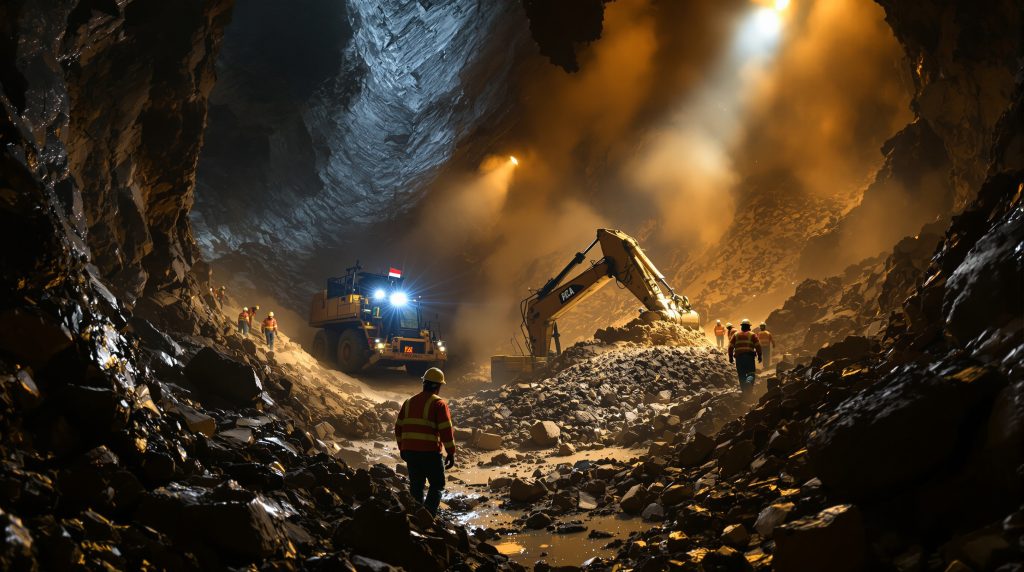The Search for Trapped Grasberg Workers: Rescue Efforts and Mining Impact
As rescue operations enter their fourth week at Indonesia's Grasberg mine, the race to locate five missing workers continues amid increasingly hazardous conditions. The incident has not only created a humanitarian emergency but also triggered significant disruptions in global copper markets, highlighting the mine's crucial role in worldwide mineral supply.
What Happened at the Grasberg Mine?
The Catastrophic Mud Flow Incident
On September 8, 2025, a devastating mud flow disaster struck the Grasberg copper and gold mine in Indonesia. Approximately 800,000 metric tons of wet material surged through the underground mining complex, trapping seven workers who were performing development activities across multiple levels of the mine.
The scale of this disaster is notable even for a sector accustomed to geological challenges. The volume of material—equivalent to roughly 320 Olympic swimming pools—overwhelmed existing safety systems and created an emergency situation that immediately halted all production activities.
Current Status of the Search Operation
As of October 2, 2025, rescue teams have recovered the bodies of two workers, while five miners remain missing. The search for trapped Grasberg workers has now entered its fourth week, with Freeport Indonesia spokesperson Katri Krisnati confirming that efforts continue "relentlessly" despite increasingly challenging conditions.
Mining safety experts note that while survival possibilities diminish with time, modern rescue operations have occasionally resulted in successful recoveries even weeks after similar incidents. However, the ongoing movement of wet material and deteriorating air quality present significant obstacles to both survival and rescue efforts.
How Are Rescue Teams Approaching This Challenge?
Technical Challenges of the Rescue Operation
Rescue teams face formidable obstacles as they attempt to locate the remaining five workers. The continued movement of wet material creates unstable conditions that change daily, complicating access routes and endangering rescue personnel. The deepening search area has led to limited air circulation, with oxygen levels becoming increasingly problematic as teams penetrate further into affected zones.
These factors have classified the operation as "high-risk" according to company statements. Mining rescue specialists indicate that mud flow incidents present unique challenges compared to more common mining emergencies like roof collapses or methane explosions, as the material continues to shift unpredictably long after the initial event.
Specialized Equipment and Methodologies
To navigate these dangerous conditions, rescuers have implemented a multi-faceted technical approach:
- Excavation of two separate access routes into the affected areas to provide redundant entry points
- Deployment of heavy machinery equipped with remote control systems to minimize human exposure in high-risk zones
- Implementation of specialized ventilation equipment to improve air quality in search areas
- Utilization of advanced geological modelling to detect potential survivor locations
Each access route presents different technical challenges, with rescue teams reporting that the unstable nature of the wet material requires constant reassessment of structural supports and ventilation requirements.
What Is the Grasberg Mine's Significance?
Global Copper Production Impact
The Grasberg operation ranks among the world's largest copper and gold mines, with significant importance to global metal markets. The complete suspension of operations following the incident has already triggered price increases in global copper markets, highlighting the mine's crucial role in worldwide supply chains.
Industry data shows that Grasberg typically contributes approximately 3% of global copper production annually—a seemingly small percentage that nonetheless represents a critical supply component in a tightly balanced market. Recent copper price predictions suggest the disruption could further impact markets already experiencing supply constraints. Copper prices have jumped by approximately 4.7% since the announcement of the force majeure declaration, demonstrating the market's sensitivity to disruptions at facilities of this scale.
Economic Importance to Indonesia
The mine represents one of Indonesia's most valuable natural resource assets and a significant source of export revenue, tax income, and employment. The partnership between Freeport-McMoRan and the Indonesian government makes this operation particularly important to the national economy.
Annual contributions to Indonesia's GDP from the Grasberg complex are estimated at $4-5 billion, while the operation directly employs over 30,000 workers and indirectly supports tens of thousands of additional jobs in related services. Tax revenues from the operation form a substantial portion of regional government budgets in Papua province, where economic alternatives remain limited.
How Has This Disaster Affected Mining Operations?
Force Majeure Declaration
Freeport-McMoRan, the mine's operator, has declared force majeure—a legal provision that exempts companies from contractual obligations due to extraordinary circumstances. This declaration signals the severity of the operational disruption and its impact on the company's ability to fulfill supply commitments.
The force majeure announcement has particularly affected metal refineries in Asia that rely on Grasberg concentrate for their operations. Several smelters in China, Japan, and South Korea may need to secure alternative supply sources or potentially reduce production rates while the mine remains offline.
Production Outlook and Recovery Timeline
The company has significantly reduced its sales estimates for the coming periods. According to industry innovation trends, copper and gold output from Grasberg is expected to be approximately 35% lower than previously forecasted through 2026, with a phased restart potentially beginning in early 2026.
Mining engineers familiar with similar incidents suggest that recovery will involve multiple stages:
- Initial safety assessment and stabilization of affected areas
- Remediation of damaged infrastructure and drainage systems
- Implementation of enhanced monitoring systems to prevent recurrence
- Gradual resumption of production, beginning with unaffected sections
The recovery timeline will depend heavily on findings from the ongoing investigation and regulatory approvals from Indonesian authorities.
What Safety Measures Were in Place?
Pre-Incident Safety Protocols
Mining operations at high-risk sites like Grasberg typically implement extensive safety measures designed to prevent and mitigate disasters. Standard protocols would likely have included:
- Regular geological stability assessments using seismic monitoring equipment
- Water management systems to control underground water flows and pressure
- Emergency response protocols for various disaster scenarios, including mud flows
- Continuous monitoring of ground conditions and potential hazards
Mining safety experts note that underground operations in geologically complex environments always carry inherent risks despite modern safety systems. The investigation will focus on determining whether early warning signs were present and properly evaluated.
Post-Incident Safety Improvements
Following this disaster, industry experts anticipate that both Freeport and the broader mining sector will implement enhanced waste management solutions particularly for operations in geologically complex environments. These may include:
| Safety Enhancement Area | Potential Improvements |
|---|---|
| Early Warning Systems | Advanced sensors to detect ground movement and water accumulation |
| Emergency Response | Improved evacuation routes and rescue equipment positioning |
| Geological Monitoring | More frequent assessment of high-risk mining zones |
| Worker Training | Enhanced disaster response training for all underground personnel |
| Communication Systems | Redundant emergency communication networks with battery backup |
| Refuge Chambers | Additional emergency shelters with extended life support capacity |
The mining industry typically responds to major incidents with regulatory and voluntary safety improvements that become standard practice across similar operations globally.
How Does This Compare to Other Mining Disasters?
Recent Mining Incidents Worldwide
The Grasberg incident joins several other significant mining disasters in recent years that have shaped industry safety practices:
- 2023 Zambian Copper Belt Collapse: 11 miners trapped, 8 rescued after 5 days
- 2024 Chilean Copper Mine Flood: 3 workers lost, operations suspended for 6 months
- 2022 South African Gold Mine Fire: 4 casualties, led to industry-wide safety review
While each incident involves unique circumstances, mud flow events are particularly challenging for rescue operations due to the unstable nature of the material and the difficulty in creating stable access routes.
Lessons from Previous Rescue Operations
Successful rescues at other mining sites have demonstrated that survival is possible even after extended periods underground, depending on specific conditions. Critical factors that influence survival possibilities include:
- Access to breathable air pockets within the collapse zone
- Availability of water sources (even from mine seepage)
- Temperature conditions within trapped areas
- The structural integrity of surrounding areas providing protected spaces
Previous rescue successes have often relied on establishing communication with trapped miners and delivering supplies through small-diameter boreholes while larger rescue tunnels are constructed—a methodology currently being attempted at Grasberg, according to Reuters.
What Are the Environmental Implications?
Immediate Environmental Concerns
The mud flow not only threatens human life but also presents potential environmental hazards that extend beyond the mine's boundaries:
- Possible contamination of groundwater systems with mining-related compounds
- Disruption of local watershed dynamics affecting downstream communities
- Potential release of processing chemicals or fuel into surrounding ecosystems
- Increased sedimentation in waterways due to disturbed material
Environmental monitoring agencies are typically deployed following such incidents to establish baseline conditions and track any developing impacts on surrounding ecosystems.
Long-term Environmental Monitoring
Environmental authorities will likely require extensive monitoring of the area following the incident, creating a comprehensive assessment program that includes:
- Water quality testing in surrounding waterways and aquifers
- Soil contamination assessments in potentially affected areas
- Evaluation of potential impacts on local biodiversity and protected species
- Remediation planning for affected areas based on contamination findings
Mining industry environmental specialists note that modern recovery plans typically incorporate environmental remediation as an integral component of operational restart planning.
What's Next for the Grasberg Mine?
Investigation and Recovery Process
Before operations can resume, a thorough investigation into the causes of the mud flow will be conducted by both company experts and independent authorities. This comprehensive process typically involves:
- Detailed geological analysis of the affected areas and surrounding formations
- Review of all operational procedures and decisions leading up to the incident
- Assessment of warning systems and their effectiveness in predicting the event
- Determination of preventative measures required before resuming operations
The findings will likely influence not only Grasberg's future operations but also safety standards across the global mining industry, particularly for operations in similar geological environments.
Future Operational Timeline
Industry analysts project the following recovery timeline based on comparable incidents in the mining sector:
- Q4 2025: Continued search, recovery, and investigation efforts
- H1 2026: Potential phased restart of limited operations in unaffected areas
- Late 2026: Progressive expansion of operations as remediation completes
- 2027: Possible return to pre-incident production levels, pending safety clearances
Regulatory approvals from Indonesian authorities will significantly influence this timeline, with safety considerations likely taking precedence over production goals. Recent gold prices analysis suggests the disruption at this major gold producer could further impact precious metals markets already at historic highs.
FAQs About the Grasberg Mine Incident
How long can miners potentially survive in underground conditions?
Survival duration varies greatly depending on specific conditions including air quality, temperature, access to water, and the presence of injuries. In some past mining incidents, survivors have been rescued after more than two weeks underground when trapped in areas with breathable air and some water access.
The Chilean mining accident of 2010 demonstrated that survival for over two months is possible under favorable conditions with adequate supplies, though such extended rescues remain exceptional rather than typical.
What technologies are being used in the rescue effort?
Rescue teams are utilizing an array of specialized technologies including remote-controlled heavy equipment to minimize human exposure in unstable areas, specialized imaging systems including thermal and acoustic detection devices, air quality monitors that can detect signs of human presence, and communication devices designed to detect signals through solid rock and debris.
Many modern mines also install tracking systems that can help locate workers' last known positions before an incident, potentially narrowing search areas.
How will this incident affect global copper prices?
The suspension of operations at Grasberg has already caused upward pressure on global copper prices. Analysts predict continued price volatility until production resumes or alternative supplies enter the market to offset the shortfall.
The timing of this disruption is particularly significant as global copper inventories were already at historically low levels, with multiple large-scale electrification projects worldwide increasing demand for the metal. Price increases may accelerate if the production shutdown extends beyond early 2026.
What support is being provided to the families of trapped miners?
While specific details about family support have not been publicly disclosed, mining companies typically provide comprehensive assistance programs during such crises including:
- Regular briefings on rescue progress through dedicated family liaison officers
- Psychological support services for family members
- Financial assistance to cover immediate needs
- Medical support for stress-related conditions
- Accommodation near the mine site for families from distant communities
Industry practice has evolved to recognize the critical importance of transparent and compassionate communication with affected families throughout rescue operations.
Will this incident affect Freeport's mining permit negotiations?
According to government statements, discussions about extending Freeport's mining permit beyond 2041 are proceeding separately from the emergency response, though safety performance will likely factor into future regulatory decisions.
Mining policy experts note that the Indonesian government's approach to the incident—balancing support for the rescue operation with appropriate oversight—will likely influence the tone of future negotiations. The company's demonstrated commitment to safety, environmental protection, and community support during the crisis will be carefully evaluated by regulatory authorities.
Further Exploration
Readers interested in learning more about mining safety and rescue operations can explore educational resources available from industry publications that provide comprehensive coverage of global mining developments and safety practices.
For those seeking to understand the broader implications of mining incidents on global supply chains, commodity market analysts regularly publish assessments of production disruptions and their potential market impacts, particularly for critical metals like copper that play essential roles in energy transition technologies.
Want to Stay Ahead of the Next Major Mining Discovery?
Discovery Alert's proprietary Discovery IQ model provides real-time notifications of significant ASX mineral discoveries, turning complex geological announcements into actionable investment insights. Explore historic returns from major discoveries and position yourself ahead of the market by visiting our discoveries page to start your 30-day free trial today.




